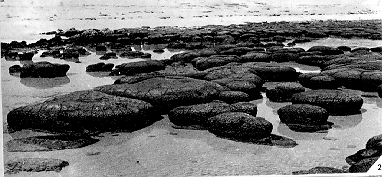Paleo-Current Indicators
Stromatolites,
in effect, can indacte the direction of paleo-currents. They can
form in elongate forms that show the trend of currents, or they can be
inclined and asymmetric and can be used to determine the sense of direction,
basically landward or seaward, and the orientation of the shoreline.
The stromatolites in Shark Bay, Australia have been used to reconstruct
a paleocurrent system in proterozoic sediments based on their shape and
orientations. It was found that their elongate elliptical,  columnar
structure was parralel with the direction of wave scour, and in turn normal
to the shoreline.
columnar
structure was parralel with the direction of wave scour, and in turn normal
to the shoreline.
Although
most investigations of ancient and modern stromatolites have concluded
to form normal to the shoreline, some stromatolites have shown different
orientations. There have been stromatolites described from the Proterozic
that are believed to have formed parallel to the coastline based on paleocurrent
directions that were interpreted from associated sedimentary structures.
The elliptical shape of the stromatolites are thought to have been the
result of tidal currents running parallel to the length of an elongated
embayment in the Precambrian Sea.